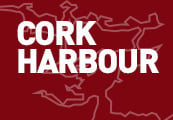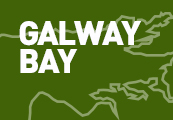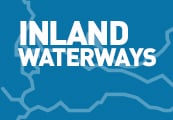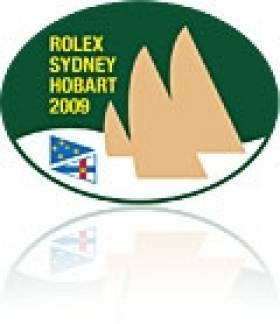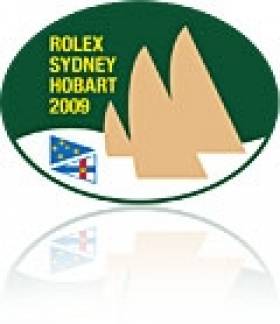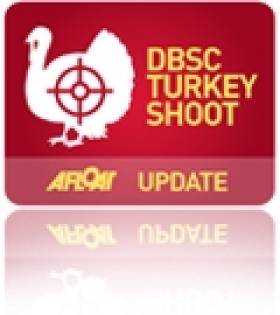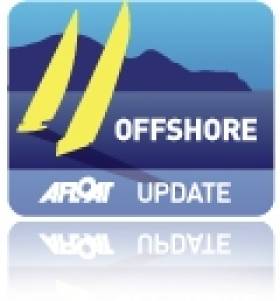Displaying items by tag: Kenneth Rumball
Dun Laoghaire Sailing School To Contest 2016 Round Ireland Race
2015 was a busy year for the Irish National Sailing & Powerboat School and the school is hoping to be even busier in 2016 writes school principal Kenneth Rumball.
2015 was a huge year of change for the Irish National Sailing & Powerboat School. With thousands of sailors introduced to the sports of both sailing and powerboating at all levels. 2015 saw us invest hugely with the addition of LYNX our first yacht and new powerboats including a 9m and 6.5m RIB. We were delighted to be successful in all areas teaching new persons to sail and introducing old clients to the thrills and spills of dinghy, keelboat and yacht racing.
2016 is already looking to be just as challenging with LYNX currently undergoing a refit ahead of the Round Ireland Yacht race where we have already nearly sold all the places available for the trip around. 2016 will see us invest further in our dinghy fleet with new purchases already underway.
We look forward to helping you in 2016 with whatever course you need.
#dlregatta – With the Kinsale ICRA Nats/Sovereigns Trophy 2015 very successfully concluded last weekend, and a classic Dun Laoghaire to Dingle Race put stylishly in place before that, the feeling of another sailing summer busily in progress is all-pervasive. But while the image projected may well be one of stately progress by the cruiser-racer fleets along the Irish coast, taking in an offshore race here and a regatta there with much leisurely cruising in between, the reality is usually otherwise. For those boats doing significant segments of the programme, it's a case of fitting chosen events into the usual hectic early summer life of work and family commitments and exams and everything else, with the re-location of boats to the next venue being a hurried task undertaken by delivery crews.
Next week sees the mid-season peak of the sailing summer, with the four day Volvo Dun Laoghaire Regatta 2015 in Dublin Bay from Thursday July 9th to Sunday July 12th. In a way it is an amalgamation of all that has has already occurred in this year's season, together with new elements to make it a unique sailfest which celebrates the fact that the citizens of Ireland's capital city and their guests can be conveniently sailing and racing within a very short distance of the heart of town. W M Nixon sets the scene
In the dozen or so years since its inception, the biennial Volvo Dun Laoghaire Regatta has settled itself firmly into the sailing scene as an exceptionally varied event in terms of the boats and classes taking part. There are five regular cruiser-racer classes, plus an offshore division, fourteen one design keelboat classes, and nine dinghy classes. And although there are contenders from Ireland's north coast and from the Cork area and south coast too, together with one gallant entry from Galway, it is essentially an Irish Sea Sailfest, though with a remarkably strong Scottish presence.
However, it was on the coast of Wales at 8.0pm last night that this sailing celebration began, with an ISORA Race starting in Holyhead and heading for Dun Laoghaire to set this large and complex programme into action towards a culmination on Dublin Bay in eight days time with the conclusion of VDLR2015.
2015 marks the Bicentennial of the Royal Dee YC, which was founded in 1815 on the Cheshire shores of the River Dee estuary where northwest England marches with northeast Wales. Originally the Dee Yacht Club (and founded, it's said, a month or two before the Royal Yacht Squadron came into being in the south of England, making the RDYC the second-oldest Royal yacht club in England after the Royal Thames), the Cheshire club became the Royal Dee YC in 1847.
Although the great prosperity of Liverpool in the 19th century saw the club's fleet of substantial yachts gathered in the Dee and then increasingly in the Mersey, by the late 1900s it was looking to the Menai Straits area as the focus of its keelboat events. As well, the completion of Holyhead breakwater in 1873 added a new and important harbour to its list of possible big boat sailing locations, and there was an increase in the number of cross-channel "matches" which the Royal Dee and the Royal Mersey, in conjunction with the Dublin Bay clubs, had already been running for some years.

A Royal Alfred YC cross-channel match from Dublin Bay to Holyhead gets under way in 1888. Cross-channel links were strong in the latter half of the 19th Century, and with the new breakwater completed at Holyhead in 1873, a new venue was available both for the Irish clubs and those on the other side such as the Royal Dee and the Royal Mersey

The bicentenary logo of the Royal Dee YC. In 1815, this club on the Cheshire coast was founded shortly before the Royal Yacht Squadron in the souh of England, whose Bicentennial is being celebrated at the end of July.

Dun Laoghaire saw its first regatta staged in 1828, and participation by yachts from the northwest of England and North Wales was regularly recorded. This is the Royal St George YC regatta of 1871.
So when we say that the Royal Dee has always been a stalwart of offshore racing in the Irish Sea, we're not referring to a story spanning only the 20th and 21st Centuries. On the contrary, it goes well back into the 1800s. And now, with the revival of keelboat sailing in the Mersey with several of Liverpool's myriad docks being given over to recreational use, we have in a sense come full circle with enthusiastic Dublin Bay support of the Bicentennial celebrations reflecting sailing links which go back almost 200 years
The Lyver Trophy is the Royal Dee's premier offshore challenge, and this year it is special, as it's a fully-accredited RORC event counting for points in the annual championship, and a highlight of the ISORA Programme 2015. It's start scheduled for yesterday evening in Holyhead will see the fleet – mostly regular ISORA contenders – sail a course of at least a hundred miles before finishing in Dun Laoghaire. Then as VDLR 2015 gets under way, races in it, combined with the Lyver Trophy results, will count as part of a series towards finding an overall winner of the RDYC Bicentennial Trophy.
Only entrants in the Lyver Trophy race are eligible, and for that race itself – which can be followed on the Averycrest Yellowbrick Tracker - the favourite has to be the Shanahan family's J/109 Ruth, still buoyed up by her great victory in the Dun Laoghaire to Dingle Race three weeks ago.

Back in The Bay – the Shanahan family's J/109 Ruth will be back in her home waters of Dublin Bay after winning the Dun Laoghaire to Dingle Race and completing the Lyver Trophy Race from Holyhead which started last night. Photo: David O'Brien
At the other end of the size scale, the VDLR2015 Dublin Bay programme includes several dinghy classes, and the biggest fleet will be mustered by the International GP 14s, who have designated the racing in Dublin Bay as their Leinster Championship. In an interview with Sailing on Saturday in March, VDLR Chairman Tim Goodbody emphasised that, overall, the event should be seen as a regatta rather than a championship, and for most boats that's just what it will be. But the GP 14s with their great esprit de corps have always done things their own way, and with their compact boat size – albeit comprising a large fleet of dinghies – they reckon they can get in a proper championship while sharing in the fun of the event.
 The brothers John and Donal McGuinness of Moville Sailing Club in Donegal are expected to be among the pace-setters in the GP 14 class with their superb Alistair Duffin-built boat. Photo: W M Nixon
The brothers John and Donal McGuinness of Moville Sailing Club in Donegal are expected to be among the pace-setters in the GP 14 class with their superb Alistair Duffin-built boat. Photo: W M Nixon

The GP 14 Ulsters 2015 were recently won on Lough Erne by Shane MacCarthy & Damian Bracken of Greystones
As to who is favourite, the McGuinness brothers – Donal and John - from Moville in Donegal, with their top-of-the-line Duffin boat built in Northern Ireland, have to be in the reckoning after being top Irish at last year's Worlds on Strangford Lough, but there's fresh blood in the fleet with the newest class developing at Youghal, while this year's recent Ulster Championship on Lough Erne was won by the Greystones duo of Shane MacCarthy and Damian Bracken.
The dozen and more boats coming south from Scotland, most of them substantial cruiser-racers, are testimony to a growing trend in sailing on Europe's Atlantic seaboard. Given a choice of venues, your average yachtie on this long coastline will incline to head south if at all possible. Other things being equal, it's reckoned the further south you go the warmer it is likely to be. And from the upper reaches of the Firth of Clyde, there are times when Dublin Bay might seem like the distant and sunny Mediterranean.
Maybe so, but we'd caution that much depends on the moods and location of that all-powerful weather determinant, the northern Polar Jetstream. In July, so long as it's well clear of Ireland -whether to the north or the south - we will have glorious high summer, and that occurred for the previous VDLR back in 2013, where the photos speak for themselves.
So we hope for the best in looking forward to welcoming a fleet of around 415 boats to Dun Laoghaire between July 9th and 12th, with all four of our in-harbour yacht clubs extending the hand of hospitality in a regatta tradition that goes right back to 1828. But while heritage and ceremonial are all very well in their place, it's the prospect of good sport which energises the participants and their sailing, and with several major contests already logged in 2015, what can we expect on the leaderboards next week?
At the top of the tree, Class 0 has formidable competition, including former Scottish champion Jonathan Anderson racing his XP38i Roxstar against the Royal Cork's Conor Phelan with the Ker 37 Jump Juice, which was one of the best performers in last year's ICRA Nationals at the same venue, and this year again became a force to be reckoned with as the breeze sharpened in the four day Kinsale ICRA Nats 2015/Sovereigns Cup a week ago.
 Freshly squeezed – her storming finish to last weekend's final race of the ICRA Nats/Sovereigns Cup at Kinsale makes Conor Phelan's Ker 37 Jump Juice one of the top contenders in the VDLR2015. Photo: David O'Brien
Freshly squeezed – her storming finish to last weekend's final race of the ICRA Nats/Sovereigns Cup at Kinsale makes Conor Phelan's Ker 37 Jump Juice one of the top contenders in the VDLR2015. Photo: David O'Brien
With a win in the final race, Jump Juice came in second to seasoned campaigner George Sisk's class overall winning Farr 42 WOW (RIYC), the pair of them in turn displacing the early leader, lightweight flyer Mills 36 Crazy Horse (ICRA Commodore Nobby Reilly & Alan Chambers, HYC) down to third in the final day's racing, so Crazy Horse will be hoping for a return of lighter breezes when racing starts next Thursday on Dublin Bay.
In the previous Volvo Dun Laoghaire Regatta in 2013, the most successful boat in was Nigel Biggs' much-modified Humphreys Half Tonner Checkmate XV, but this year the Biggs team is racing as Checkmate Sailing with the newest boat in the fleet, the Mark Mills-designed American-built C & C 30 OD Checkmate XVI. She may be only 30ft LOA, but she's such a hot piece of work with so many go-fast bells and whistles that she has a rating of 1.140 to put her in Class 0.
The oldest boat in the cruiser-racer fleets will be found in Class 3, where the 44ft Huff of Arklow is making an historic return to Dublin Bay racing. Originally built in 1951 by Jack Tyrrell of Arklow to a design by dinghy genius Uffa Fox, Huff is so-called because her concept is reckoned three-quarters Uffa Fox and one quarter Douglas Heard. The latter was the founding President of the Irish Dinghy Racing Association in 1946, and he later went onto to become Commodore of the Royal St George YC and a noted cruising and offshore racing enthusiast with this unusual boat, which is like a very enlarged Fying Fifteen with a lid – in fact, with her 30ft-plus waterline, she was described as a Flying Thirty. In recent years she has undergone a total restoration with Cremyll Keelboats near Plymouth in Devon, and Dominic Bridgeman of the Cremyll group will be racing her with trainee crews in her old home waters of Dublin Bay.

The Flying Thirty Huff of Arklow racing off Dublin Bay while under Douglas Heard's ownership in the 1950s. Built by Tyrrell's of Arklow in 1951, the hugely innovative Huff has recently had a major restoration, and will be making her return to Dublin Bay to take part in VDLR2015.
Among the newer boats on the bay, the 2013 champion Checkmate XV is still very much in the picture, but now she's owned by Howth's Dave Cullen, and took second overall in class in the Kinsale series a week ago. In Dun Laoghaire next week, she's with other Half Tonners at the lower end of the Class 2 rating band on 0.944, almost 200 rating points below the new Biggs boat. Class 2 also includes the Division 3 winner at Kinsale, Richard Colwell & Ronan Cobbe's Corby 25 Fusion (HYC) which bested VDLR 205 Chairman's Sigma 33 White Mischief in a real duel after they went into the final day's racing equal on points, while another Kinsale success story in the Class 2 lineup is Paddy Kyne's X302 Maximus from Howth, overall winner of the Portcullis Trophy for top ECHO boat.

Dave Cullen's modified Half Tonner Checkmate XV will be looking to take the top slot on Dublin Bay after being runner-up in Kinsale. Photo: David O'Brien
In between the two Checkmates on ratings, we find most of the cruiser-racer fleet, with Class 1 shaping up some interesting competition between the likes of Paul O'Higgins Corby 33 Rockabill (RIYC), Kenneth Rumball skippering the Irish National Sailing School's Reflex 38 Lynx, and two very sharp First 35s, Prima Luce (Burke, Lemass & Flynn, NYC & RIYC) and another former Scottish Series champion, John Corson (Clyde Cr C) with Salamander XXI.
This year's Scottish Series Champion and the Afloat.ie "Sailor of the Month" for May, Rob McConnell of Dunmore East, will certainly be racing in the VDLR 2015, but whether or not it's with his all-conquering A35 Fool's Gold (second in class at Kinsale) or aboard another boat (a Flying Fifteen) remains to be seen. And the Top Sailor Count doesn't end there, as there'll be at least four Olympic sailors involved in four different classes, with Robin Hennessy racing in what has all the marks of a quality International Dragon fleet against the likes of former Edinburgh Cup winner Martin Byrne, Annalise Murphy racing in the Moths which will surely be a change from the Water Wag which she raced with her mother Cathy MacAleavy (also another ex-Olympian) last time round, and Mark Mansfield helming John Maybury's J/109 Joker 2. After Joker 2's class overall win in Kinsale, we can expect a battle royal in the J/109s with boats of the calibre of Ruth for the National title fight.

The Shipman 28s find that the sport and socializing which the VDLR guarantees will provide some of their best racing of the year. Photo: VDLR
The J/109s are the queens of an impressive array of One Design keelboats which includes Sigma 33s (where VDLR 2015 Chairman Tim Goodbody's White Mischief is racing under the command of Paul McCarthy), Beneteau First 31.7s, Shipman 28s having one of their best gatherings of the year, Ruffian 23s with a good turnout, the attractive First 21s which are steadily gaining traction as a Dublin Bay class, and best OD keelboat turnout of all is by the Flying Fifteens, nearly all of them under the NYC flag.

Olympians all – in VDLR2013, Olympic sailors Cathy MacAleavey (1988) and her daughter Annalise Murphy (2012) raced the family Water Wag Mollie. But while Cathy will be sailing Mollie again this year, Annalise will be on her own racing a foiling International Moth.

Newest of the oldest – Adam Winkelmann and Doug Smith's new French built Water Wag No.46, Madameoiselle, has been launched in time for the regatta. Photo: Owen McNally

The Howth 17s of 1898 vintage will be the oldest class racing. Photo: David Branigan
Veteran classes include the IDRA 14s from 1946, the Glens from 1945, the Howth 17s of 1898 which pre-date the 1902 Water Wags, and the 1932 Mermaids, the latter being in the interesting position of no longer having an official division in Dun Laoghaire, yet it's a Dun Laoghaire skipper, Jonathan O'Rourke of the National, who continues to dominate the class both at home and away.
With large fleet numbers afloat guaranteed, the shoreside programme is appropriately busy, with the official side of each day's racing concluded by the evening's daily prize-giving at one of the four waterfront clubs. But with so many sailors involved, there'll be action in all the clubs – and at other establishments in Dun Laoghaire - throughout the week. The scene is set, let the party begin at a venue which has been staging regattas since 1828.
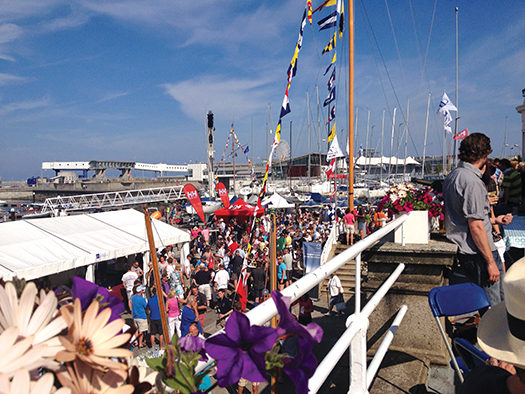
When the summer comes, the après sailing at the VDLR is world class. Photo: VDLR
Further reading:
Download the full entry list for Dun Laoghaire Regatta 2015 class by class below
Download the Sailing Instrcutions for Dun Laoghaire Regatta 2015 HERE
- Dun Laoghaire Regatta
- Volvo Dun Laoghaire Regatta
- Royal St George Yacht Club
- Royal Irish Yacht Club
- National Yacht Club
- ISORA
- Water Wags
- Royal Alfred Yacht Club
- yellowbrick
- GP 14
- Nigel Biggs
- George Sisk
- Annalise Murphy
- Half Tonners
- Tim Goodbody
- Mermaid
- Fool's Gold
- Dragon
- Irish National Sailing School
- Kenneth Rumball
- Dublin Bay
#inss – Last week, Sailing on Saturday featured the Royal Cork Yacht Club, the oldest in the world, as it comfortably donned the mantle of the ISA/Mitsubishi Motors Sailing Club of the Year 2015. This morning, we find ourselves involved with what may well be the newest sailing club in the world, the Irish National Sailing Club. It is certainly, thanks to being inaugurated nearly three months after Youghal SC was founded on 28th October 2014, the newest in Ireland. W M Nixon tries to explain it all as he finds himself in the world of Irish sailing's most complete dynamo.
Alistair Rumball is a Life Member of the Awkward Squad. Cage-rattling and pot-stirring are second nature to him. But it's not because of experiencing an unhappy childhood. On the contrary, while growing up in Malahide, his boyhood summers were bliss. He and his brother Arthur had as much sailing as they could want, fitted in between part-time jobs raising pocket-money with a morning picking potatoes at Dermot Dickie's farm along the Broadmeadow Estuary, followed by an afternoon of sailing the sea with the sun always shining, and then maybe an evening of club racing followed by the easy camaraderie among kids who are comfortable with boats.
It was an idyllic maritime environment which, over the years, has produced some of Ireland's top racing and cruising sailors. But while the young Rumball was no slouch on the race-course, the strongest feeling he had about sailing was the sheer fun of it all, the totally absorbing wonder of being in a boat and hauling on ropes to make sails change shape and help you along your chosen course over the always interesting sea.
Although he graduated from Trinity College Dublin as an engineer, he increasingly had this almost evangelical attitude to spreading the good news about the fun of sailing. And while he has something of a reputation – to say the least - for being confrontational, it's central to his contradictory character that he's an extremely good teacher. If somebody shows the slightest genuine enthusiasm about wanting to learn to sail, Alistair Rumball has been prepared to go to endless lengths to teach him or her to do so, and to do so with enjoyment.
Underlying that, we find the first of his gripes about the modern sailing scene. He reckons that it has become far too serious. Don't think for a moment, though, that he believes in a frivolous approach to boats and sailing. He's deadly serious about having everything just right as regards safety and function.
But once that's sorted, then he firmly believes that you should go out and enjoy it. He waxes lyrical about moments of sheer sailing ecstasy he has enjoyed in a wide variety of boats in many sailing locations worldwide. And whatever he may have formally set out to be in a professional career, his working life has been spent in and around boats, getting people introduced to boats and out afloat, sometimes on an almost industrial scale.
Time was when sailing skills were something you acquired by a sort of osmosis through family tradition, club opportunities, and friendship examples. That's mostly how Rumball himself learned to handle a sailing boat. But he seems to have this almost messianic zeal to teach people to sail, and he became convinced that the future lay in more structured training with a proper syllabus.
Having taken a long hard look at the population distribution of the Greater Dublin area and where they might best get afloat in worthwhile numbers, in 1978 he acquired the assets of a moribund organisation, the Dun Laoghaire Sailing School, and soon found himself giving his first lessons to two pupils using a fibreglass-clinker Darragh 14 knockabout sailing dinghy which they'd launched from the public slipway in the Coal Harbour in Dun Laoghaire. The long journey had started towards an organisation whose activities today today include top-of-the-line race training in 1720s in winning mode:
The majestic granite harbour of Dun Laoghaire was a cold place in 1978 for any young enthusiasts trying to set up an independent sailing school on a commercial basis. For the powers that be, sailing was something to be learned through family and clubs under the Junior Training Programme of the Irish Yachting Association. If you were a young person or adult from a non-sailing background but keen to learn, unless you'd an obliging and patient friend from within the sailing establishment, the expectation was that you'd take yourself off to somewhere far away like the Glenans Ireland bases in Baltimore and Bere Island and Clew Bay, and eventually reappear after a decent interval with enough experience, newfound ability and contacts to make the grade in the Dublin Bay sailing scene, where the very thought of a raw in-harbour sailing school for outsiders seemed distasteful to the establishment.
Yet hidden away in the southwest corner of Dun Laoghaire harbour, here was this gadfly of the sailing scene, Can–do Alistair with his rough and ready sailing school enthusiastically recruiting pupils anywhere and everywhere, and taking them afloat in boats which may not have been in the most pristine condition, and certainly set sails which would not be winners on the race course, yet they were safe and able, and so were he and his instructors.
Over the years, an entire cohort of people, mainly from Dublin but also from all over Ireland with a useful smattering of pupils from abroad, came to boats and sailing thanks to this wild-haired character whose love of his demanding work shone through everything he did.
Gradually the fleet expanded, and so too did the "Rumball Group's" activities, even though the very limited availability of premises on the Dun Laoghaire waterfront meant that every little square foot they had always seemed to serve at least three different purposes. But they were getting there, they opened a retail outlet in the town to sell boat gear and equipment which became Viking Marine, the school promoted itself to being the Irish National Sailing School, and they were well settled in place, using every inch of space on the ground floor of the interesting little building on the southwest corner of the harbour which used to be the Nautical College.

The man and his machines – Alistair Rumball and his chariot outside the Irish National Sailing School's HQ in Dun Laoghaire. Photo: W M Nixon
Centuries ago, seafaring education was given a significant role in Irish life in the late 1700s, the 1800s, and the early 1900s with the old Marine School a fine building on the south quays in Dublin. But its premises were re-allocated for development purposes and the school itself had its final home in Clontarf before being absorbed only as a vague memory into what is now Mount Temple Comprehensive school.
These days, the marine education focus has moved to Cork with the fabulous new National Maritime College in Ringaskiddy, but for that low period in Irish maritime life in the mid 20th century, one of the few keepers of the flame was Captain Tom Walsh who operated the little Nautical College in this fairly inconspicuous Office of Public Works building now hidden away behind the Dun Laoghaire Motor Yacht Club.

Captain Tom Walsh in teaching mode in 1957 in the INSS building when it was the Nautical College.

The 110ft barquentine which Jack Tyrrell designed for Captain Tom Walsh's Nautical College in 1954 in the hope that it would inspire the building of an Irish Tall Ship
It was the gallant Captain Walsh who in 1954 commissioned Jack Tyrrell of Arklow to design a 110ft sailing ship – a barquentine – to be Ireland's very own tall ship, our first sailing training vessel. God bless the good captain, but he was convinced that if he could just get someone in Government to see these inspiring plans, then such a ship would be on the way.
You can imagine just how far such a visionary idea travelled in the deadly dull Ireland of the 1950s. Far from getting a proper training ship built, Captain Walsh had enough trouble keeping his college in being. Yet he was a gentleman and enthusiast to the end, and after retirement he augmented his pension by testing compasses in yachts, which I remember well as he did it for me with a little cruiser in 1981. The only mutually convenient time it could be done was on a Saturday evening, and I'd to get the boat from Howth to Dun Laoghaire to do it, but the actual swinging of the compass by Tom Walsh was such a pleasant and educational experience that any thoughts of being at some Saturday night party were entirely banished.
So when you go into the main premises of the Irish National Sailing School today, it's natural to remember Captain Tom Walsh, and I like to think that he would thoroughly approve of the old building's current usage, for Alistair Rumball and his team are mighty busy during what must sometimes be an 18-hour day, and just this week – before the sailing season is really fully under way – Monday was typical, with 185 schoolkids bussed down from Maynooth for a day's coaching afloat, followed by all sorts of gatherings including a committee meeting of the newly-formed Irish National Sailing Club.
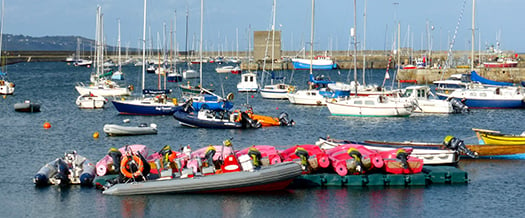
Space is so constrained that a floating dinghy park has to be used to store the smaller craft. Photo: W M Nixon
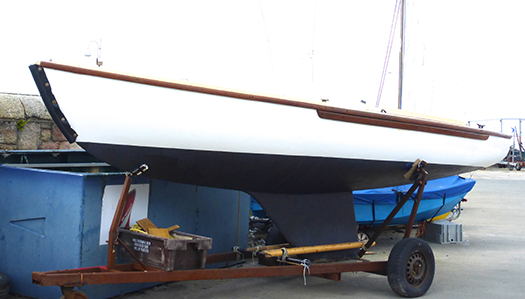
Thanks to the special INSS fendering devised by Arthur Rumball, this 35-year-old Squib has survived many seasons of tough teaching in good order. Photo: W M Nixon
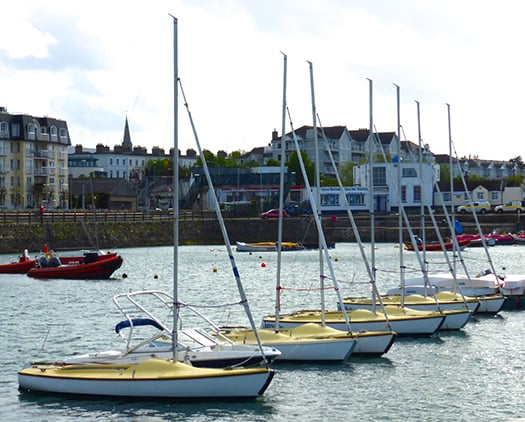
To economise on space, the Squibs berthed here, with the INSS building in the background, are double-moored. Photo: W M Nixon
Of which more anon, for this bare outline gives only a hint of the INSS's complex programme. The Rumball theme is that you have to keep operations and facilities flexible to cope with fluctuating demand, for at the height of the season the school is operating a fleet of 200 boats ranging from kayaks through sailing dinghies of increasing size, then on into keelboats of which some well-fendered Squibs are the workhorses while 1720s provide the glamour input, and finally at the top of the tree there's the Reflex 38 Lynx, bought from Galway this past winter, and becoming part of a programme headed by Alistair's son Kenneth – a Silver Youth Medallist in the 420 – who is now a fully-qualified offshore racing pro teacher, but also races the 1720s while being main operations director of a school which has five full–time employees, but in all has sixty staff at the height of the season.
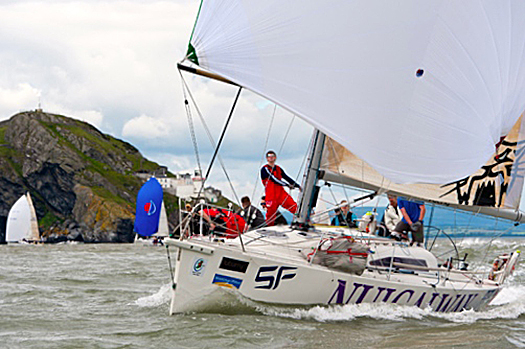
The latest addition to the INSS fleet is the Reflex 38 Lynx, seen here racing for NUI Galway during the Round Ireland. In 2015, Lynx has already scored a second overall in ISORA racing skippered by Kenneth Rumball.
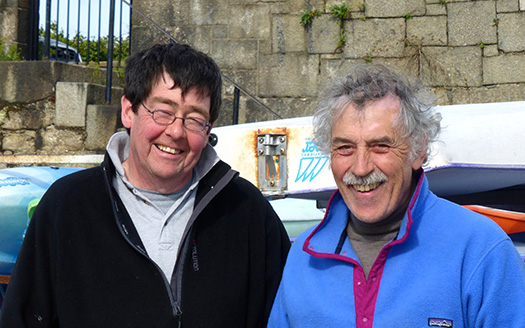
Brothers in business – seen here with his brother Alistair, Arthur Rumball (left) runs the often very busy INSS boat maintenance facility. Photo: W M Nixon
As to shoreside facilities, each summer they set up an additional seasonal summer base to the west of the West Pier with top-of the-line Portakabins at Salthill to provide facilities for those sailing dinghies and kayaks, and in addition the INSS have their own boat-maintenance unit under Arthur Rumball beside the boatyard in the Coal Harbour.
So an impressive amount of things have happened since 1978, the best of them surely being that Alistair persuaded Muriel, a country girl from one of the most beautiful parts of County Carlow, to marry him. For Muriel is a teacher by profession, and adept at being the peace-maker who smooths the waters after Alistair has been making waves, which even now still seems to be just about all the time.
That said, he gives the impression of having so many chips on his shoulder about the perceived opposition to his ventures by those in authority that you begin to think it might be just a bit of an act, for underneath it all he has a heart of gold, yet with the spirit of a lion who will fight the good fight to defend his territory and the interests of his family, friends, trainees and businesses.
The quality of the man was well revealed when the economic recession struck. At the height of the boom years, the Irish National Sailing School had a throughput of more than 2,500 people per month coming new to sailing, and it had become a vibrant and trendy part of the recreational fabric of good-time Dublin. Then around 2008, the economy went into free-fall. But the INSS survived both by making severe cutbacks in everything, and utilising another string in Alistair's bow.
Because of his ready enthusiasm to undertake just about everything and anything to do with boats, back in 1982 he'd looked after some waterborne scenes with classic small craft for the Channel 4 TV comedy-drama series The Irish RM, starring Peter Bowles and Bryan Murray, which went out between 1983 and 1985. It was grand at the time, but thirty years down the line it now seems to have a dose and more of the Paddywhackery about it. However, that was neither here nor there for Alistair Rumball in 1982, for it gave him a lucrative little sideline, and over the years since he has been the man to go to if you want to set up boats and sailing ship scenes in the Irish movie-making business.
So it's ironic, when we remember that Malahide was where the rather mouldy old Vikings of Dublin made their last base after their city had been captured by the Normans in 1171, that it should be a Malahide boy who has emerged as the behind-the-scenes captain of ships for the filming of the blockbuster series Vikings.

When you've spent most of your working life teaching people to sail, tutoring Thespian Viking crewmen on a Wicklow lake is just an ordinary part of another day at the office.
It has all been happening for some years now up in the Wicklow mountains and out on the Wicklow lakes, which have passed themselves off very well as Norwegian fjords, yet can double quite effectively as the coastal and riverside scenery of the many places where the Norwegian Vikings wreaked mayhem.
Who knows, but maybe with the passage of time the epic Vikings series will come to be seen as the epitome of Scandiwhackery, but for now, it certainly does the business . For as the Irish economy fell off a cliff, Alistair Rumball soared aloft in creating, managing, and manoeuvring a very authentic and substantial Viking longship flotilla which has provided a proper Tinseltown income to make all things possible, while helping underwrite the future of the Irish National Sailing School.
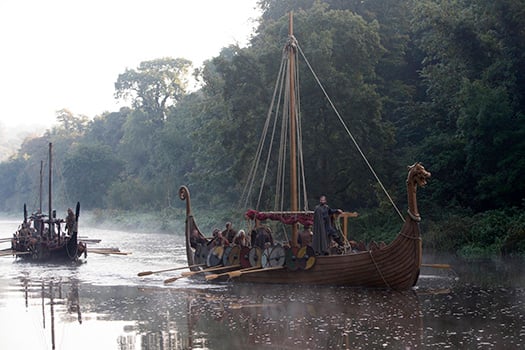
Lough Dan in County Wicklow - where Erskine Childers first sailed around 1890 – has proved remarkably versatile in providing backgrounds for the Vikings which could either be Norway itself, or else the shores of places they are raiding
But it's extraordinarily demanding and time-consuming work, even if he has a staff of 150 specialists up in the Wicklow hills, and after a year or two it became clear that he was trying to do too much. So four years ago his son Kenneth, who is now 27 and was at the time working as an accountant, moved in to take over the direction of the sailing school, and as the recession has started to recede – last year they had monthly numbers pushing back towards the 2,000 mark - Kenneth's energetic and all-encompassing input is seeing the school increasing the scale of its operations, particularly in what might be called the post-graduate side with the development of 1720s at top race level. Now the acquisition of Lynx has developed things further - she has already made what was a rather hasty debut in the first ISORA of the year, but despite being only minutes out of the box, they placed second overall, and that only by six minutes.
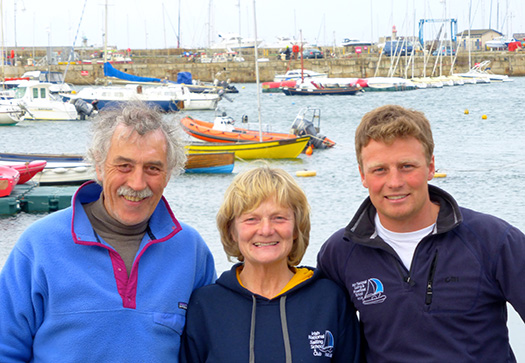
Alistair, Muriel and Kenneth Rumball. Photo: W M Nixon
This placing of racing as a natural part of the INSS syllabus has in turn led to the need for an officially-constituted club to comply with race entry requirements. But in reality the INSS has had a genuine club atmosphere for years, indeed it has more of a truly club-like atmosphere than many a historically-constituted old yacht club. So it was only a formality to bring the Irish National Sailing Club into being in January 201, but it's for real, here's a pic of the Committee of the new club meeting in the old Tom Walsh building on Monday, and if you want to join, it will cost you the outrageous sum of €10.
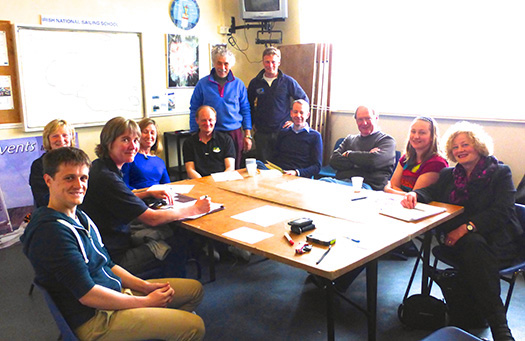
The committee and school management of the newly-formed Irish National Sailing Club are (left to right) Glyn Williams (foreground), Muriel Rumball, Joan Sheffield, Caroline Herron, Robin Jones, Alistair Rumball, Kenneth Rumball, Garrett O'Malley, Dermot Igoe, Heather Blay and Mary Beck. Photo: W M Nixon
As to how Alistair Rumball views the impending possible re-structuring of Dun Laoghaire as a cruise liner port, with inevitable limitations on the amount of sailing which can take place within the harbour, he is both an idealist and a realist.
Like many of us, he dearly wishes that this splendid granite creation could be seen as a cherished part of our heritage, not as something to be used to generate income to turn a crude profit or even just to pay its own maintenance costs. Rather, we'd ideally like to see it treated as a national asset to provide vital recreational space for everyone afloat and ashore.
But Alistair Rumball senses that the government's determination to use just about everything in public ownership to generate income will win the day, and he is already being realistic about what the regular if summer-emphasised arrival of cruise liners will mean.
In fact, he may even derive a certain sardonic satisfaction from seeing the Dun Laoghaire sailing establishment having to contemplate accepting conditions with which his school has complied ever since he began operating it.
"People should realise" he asserts, "that there are already two clearly-define shipping channels in Dun Laoghaire Harbour. One is from the harbour entrance to St Michael's Wharf, which will simply be retained if the cruise liners come. The other, much less widely known, is supposed to be from the harbour entrance to the berth at the Band Stand on the East Pier. Even at present, you are not meant to operate under sail in either of those channels, but an awful lot of boats do so."
"However, as we are a commercial operation, we have a strict policy of complying with regulations and carrying out our sail training and teaching operations in the western part of the harbour, clear of the main channel. So a cruise liner should not affect our in-harbour activities, while our larger craft going out into the bay will have to comply with shipping regulations in the entrance like everyone else".
Whatever happens, we may be sure that the Irish National Sailing School and the Irish National Sailing Club - and their splendid founder - will continue to be a thorn in the side of those who take themselves too seriously and have an inflated idea of their own importance. But if you've never been in a boat before and know nobody in sailing, yet feel a growing enthusiasm to go sailing in Dun Laoghaire, you now know where to go to experience the real thing.
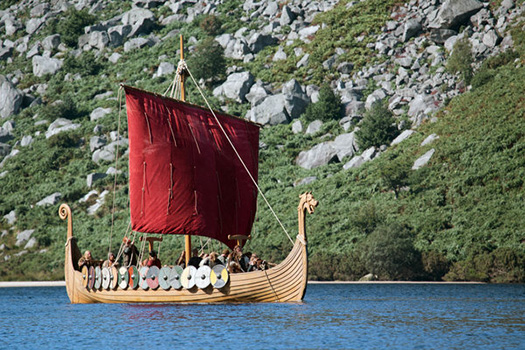
The other side of the INSS show – a Viking ship looking good on Lough Dan
11th Place Finish For Ireland's Sydney–Hobart Crew
#rshyr – Ireland's Breakthrough crew led by Barry Hurley has recovered from a lowly 25th place yesterday to finish 11th on IRC overall and seventh in class on day four of Australia's classic Sydney–Hobart race where the overall winner could still be at sea.
Only two hours before the finish the official tracker gave Breakthrough's position in the top ten overall but Constitution Dock, Hobart is buzzing with activity after a stream of boats crossed the finish line throughout Day 4 making any final overall result some time away yet.
Crossing the Tasmanian finish line in Hurley's third succesive race, the Cork Harbour sailor eclipsed last year's result of 27th overall but was a place behind the sixth place in IRC Division 3 achieved in 2013. It was a terrfic recovery over the past 24 hours when Breakthrough had slumped to 27th. Provisional race rankings here
In a race of snakes and ladders, the Irish crewed boat was only an estimated two hours off the overall handicap lead at the halfway stage of the 635–miler. In a fantastic opening peformance the New South Wales entry from Jonathan Stone and Mathew Vadas was as high as third place in the 109–boat fleet.
But after passing Gabo Island, things took a so far unexplained turn for the worse. The First 40 nose–dived down the rankings sinking at one stage yesterday to 27th overall on IRC overall with just 200 miles to the Tasmanian finish line.
Battling strong winds in the Bass Straits to recover some 16 places and seventh in division 3 was never going to be an easy proposition.
The drop in performance – an estimated 1.5 knots off the pace all day yesterday – prompted some of Breakthrough's shore crew to speculate that a torn spinnaker might be to blame. Others said the easterly course chosen by Breakthrough might have contributed to a slower wind angle.
But whatever the reason, the Hurely crew dug deep in the closing stages to haul back in near small boat rivals and take the best result to date in what has been an intriguing and record breaking 70th edition of the Australian classic.
Before the race started Hurley wrote on Afloat.ie 'Being one of the smaller boats at just 40ft, our position in the overall standings will be somewhat a result of the weather patterns during that particular week, whereas our placing within our class will be a true measure of success'. How right he was.
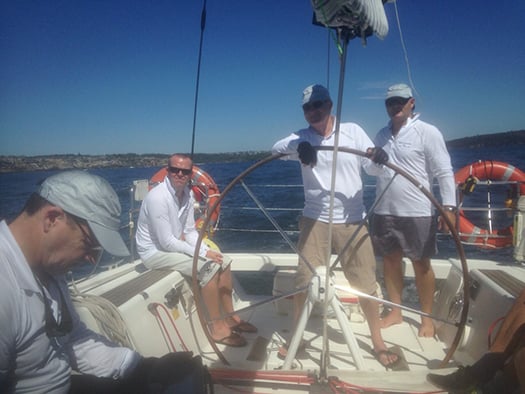
The Breakthrough crew depart Sydney
By 17:00 AEDT, 39 yachts had completed the 628-nm race, as the docks filled with tales from another dramatic contest. Of the 117 starters, 65 yachts are still sailing and a further 13 officially retired, unable to complete the course.
Veteran victory?
Current forecasts have four veteran yachts – Love & War, Quickpoint Azzurro, Wild Rose and the fleet's smallest and oldest boat Maluka of Kermandie – all in contention for overall victory. All three boats represent vast contrasts to the sleek, carbon fibre-built 100-foot Maxis which dominated the race for line honours.
Simon Kurts' Love & War is a three-time winner of the race (1974, 1978, 2006). The boat, built over forty years ago, needs to arrive in Hobart before midnight this evening to retain any chance of claiming an unprecedented fourth Tattersall's Cup. This wooden classic won in two contrasting eras of ocean racing underlining the boat's durability and the true spirit of the Rolex Sydney Hobart: any crew stands a chance of victory provided they demonstrate true teamwork, tactical nous and an intrepid spirit. Love & War, featuring veteran navigator Lindsay May competing in the race for a staggering 41st time, is currently approximately 40-nm from the finish.
Roger Hickman's Farr 43 Wild Rose is a mere 29 years old and pushing hard for that elusive first Tattersall's Cup. In poignant synergy, Wild Rose was once owned by Wild Oats XI's Bob Oatley, whose crew yesterday claimed a record-breaking eighth line honours victory. Wild Rose has already produced a stern, resilient performance, overcoming adversity on her journey south. "We had a massive broach in 30 knots this morning with the spinnaker up," Jenifer Wells, the crew's navigator reported. "We laid her over a couple of times, broke the steering cable and it was looking very dicey. "We got out the emergency tiller and pulled the kite down, repaired the cable and we were back racing in 12 minutes."
Another wooden classic is Maluka of Kermandie, a gaff-rigged huon pine beauty. Owned by one of the race's colourful characters, Sean Langman, the 30-footer still lies some 122-nm from the finish line.
Currently leading on handicap though is Shane Kearns' Sparkman & Stephens 34 Quickpoint Azzurro 108-nm from Hobart.
Happy Hobart
The crews arriving in Hobart this afternoon carried the look of seasoned offshore racers: tired, proud, red-eyed, salty and wind-swept.
"The race is always very different and always extremely challenging and this one was special as it was my wife's first Rolex Sydney Hobart," explained Philip Coombs, owner of the 42-ft Simply Fun, whose amateur crew performed miracles to even make the start line. "The team I have are brilliant. Three days before we were due to leave for Sydney our boat had extensive damage so the boat builders worked night and day for two weeks to get us ready. We are happy to be here considering all of the factors involved."
Mark Covell on the British-flagged Swan 68, Titania of Cowes, reported: "It was an absolute classic, starting off on the nose, plenty of rail time, lots of waves over the boat, before it slowly lightened up. We then got kite up and breeze kept coming up and up; we ended coming up the Derwent (River) on the nose in a hailstorm. We pretty much had everything!"
Reflective glory
Shortly after lunchtime on Day 3, Bob Oatley's Wild Oats XI claimed her eighth Rolex Sydney Hobart line honours victory in ten years. This morning skipper Mark Richards was able to reflect on a momentous achievement for the 100-foot Maxi. "An eighth Rolex Sydney Hobart line honours win is something we never would have dreamt about ten years ago. The reception from hundreds of spectator boats and tens of thousands of people on the dock is a spectacular way to finish a yacht race."
That high level of interest continues as the sailing world stands by to learn the identity of the 2014 overall winner.
Irish Crew Vying for Overall Sydney–Hobart Lead
#rshyr – Irish crewed yacht Breakthrough is an estimated two hours off the overall handicap lead at the halfway stage of the 635–mile Sydney–Hobart yacht Race. Lead by top Irish offshore sailor Barry Hurley, the New South Wales entry from Jonathan Stone and Mathew Vadas is lying 33nm SE of Gabo Island in third place in the 109–boat fleet. After its second night at sea Breakthrough has still to sail 382.5 miles to the Tasmanian finish.
Hurley has on board Dublin Bay sailors Alexander and Kenneth Rumball and Catherine Halpin along with a local Sydney crew. The Aussie–Irish team are currently behind Roger Hickman's Wild Rose and Ron Foster's Ariel on IRC handicap.
Prior to his departure Hurley wrote about preparations for his third successive Sydney–Hobart race.
Irish 'Breakthrough' Sailors Set For Sydney–Hobart Challenge
#rshyr – With less than 24 hours left to the start of the 70th edition of the Rolex Sydney to Hobart Race, Irish sailors, Barry Hurley, Catherine Halpin, Alexander and Kenneth Rumball sailing aboard the First 40 BREAKTHROUGH are completing some last minute touches prior to the start writes Kenny Rumball. The rest of the crew on the boat consist mainly of Australians with Matthew Vadas (skipper), Ben Hunter, Jonny Hoover, Adam Carpenter and Peter Thorp completing the 10 strong team.
The First 40 has undergone an extensive programme in preparation with new standing rigging, a largely new sail wardrobe and other essentials with Barry overseeing many of the upgrades throughout the year. The Australian crew have worked hard to tune the boat up in the Cruising Yacht Club of Australia Blue Water Points Score with the Sydney to Hobart being the last race in the series. Breakthrough have performed well in the series and currently stand 8th in the series and scoring a 4th place in the last race.
With the initial forecast giving 25-30kts for the first 24 hours after the start, the crew will have to work hard through the first night going down the eastern shoreline. The east Australian current will give the fleet a nice help along as they race south. The wind should hopefully swing into the north after day 1 allowing the teams to crack sails and raise spinnakers as they enter the Bass Straits. The infamous stretch of water between the south coast of Australia and Tasmania usually serves up a good test of man and ship with a large oceanic swell and some good breeze.
The 'organ pipes' on the south eastern coastline of the island of Tasmania will be a welcome sight for the tired sailors before the sail through storm bay passing the iron pot at the mouth of the Derwent river leading up to Hobart.
Irish Crews Among Small Boat Sailors Boosted By Sydney-Hobart Race Weather Forecast
#rshyr – In Sydney, forecasters have revealed that a southerly breeze will play in to the hands of smaller boats – including a number of Irish sailors – for Australia's 70th Rolex Sydney Hobart race that starts on St. Stephen's Day.
Irish crews competing in four days time include Sydney–based Gordon Maguire, orginally from Howth Yacht Club racing on the front–runner Carkeek 60, Ichi Ban. And as Afloat.ie previously reported, Barry Hurley of Cork Harbour and the Royal Irish Yacht Club leads a part Irish crew on the First 40 Breakthrough with Irish National Sailing School brothers Kenneth and Alexander Rumball and Dublin Bay sailor Catherine Halpin on board. Hurley, a Middle Sea Race Winner from October, gave an account of his Sydney–Hobart preparations here.
Locally based Irish sailor Keith Hegarty is racing his first Sydney-Hobart on Merlin, a Kaiko 51, owned and skippered by 81–year–old David Forbes, a legend in Australian sailing with an Olympic Gold Medal from Munich 1972.
There are estimated to be quite a number of Irish sailors competing in the race spread across the fleet.
Pam Lee, daughter of Greystones dinghy sailor Norman Lee, is racing on board Blacksheep, a Beneteau 45 rookie boat owned by Sharpie sailors Derek and Martin Sheppard from Wollongong. Lee is one of three girls on board and is sailing despite having her knee in plaster due to an unintended gybe during a night practice race in November when her leg got trapped by the mainsheet as she played the spinnaker sheet.
Read more on Irish participation in WM Nixon's blog here. Also more here from David O'Brien in last Friday's Irish Times Sailing column.
The early Christmas weather forecast gift to small yachts means the big glamour boats (including five maxis) may yet miss out on oan overall handicap win with smaller craft – roughly forty foot in length – favoured.
"We're really excited by this forecast," says Tom Barker, the navigator on the Ker 40 St George Midnight Rambler. "In terms of handicaps, the slow start means that is more time the big boats will have to take out of us.
The 117 yachts in the Rolex Sydney Hobart will face an early test this year, with the Bureau of Meteorology (BOM) forecasting a sharp 20 to 25 knot southerly change on Boxing Day afternoon not long after the start.
A southerly is expected to hold throughout the night at around 20 to 25 knots so it will be a long, wet first day for all crews.
Andrew Treloar from the BOM says winds will get lighter the further south the boats go, and the front runners should cross a high pressure ridge around Gabo Island giving them light westerlies across Bass Strait on Saturday.
Winds off the Tasmanian coast on Saturday night are also expected to be pretty light westerlies. They could be quite fluky.
"The midfield and tail end boats will get a better go from the wind," Treloar says. "They will tend to stay up around 10 to 15 knots right through as they cross Bass Strait and sail down the Tasmanian coast."
So this is a classic mid-sized to small boat forecast. A southerly on day one, stopping the super maxis from getting too far ahead, and a northerly after the glamour yachts are already tied up in Hobart.
INSC 1720 Sportboat Claims Line Honours in Second DBSC Turkey Shoot Race
#dbscturkeyshoot – With the tweets from the Dublin Bay Buoy giving an average wind speed of 10kts and gusts of 16kts, the two INSC teams (INSC1 skippered by Kenneth Rumball, INSC2 skippered by Alexander Rumball) headed out to the second DBSC Turkey Shoot race with smiling crews after the baptism of fire from the previous week writes Kenny Rumball. Such light southerly winds meant most 1720s thumbed a tow from passing engine driven yachts to hitch a lift to the outer harbour. As the training days for both INSC teams were mostly blown out, the two teams took advantage of the lighter conditions to practise a few hoists gybes and drops of the bigger mast head spinnakers on the 1720s.
Shifty conditions gave Fintan Cairns and his team on Freebird a tricky course to lay, so shifty that between the second and third start, there was almost a 50 degree shift from the south to south east turning a square start line into a heavily biased pin end line inside the sequence. INSC2 lined up for a run in on port tack at the pin end whereas INSC1 took a more conservative start on starboard tack near the pin end. INSC2 pulled off a great start but with a narrow infringement with a RIYC boat forcing the INSC2 team to do a few penalty turns. INSC1 got buried in the line and immediately set about rolling into a few tacks in the shifty conditions to pull back into the race. It was anybody's guess as to what was the best track up the beat, INSC2 went out towards the left side with one of the Royal St George 1720s, Merlin, helmed by Ben Cooke and the National Yacht Club entry helmed by Brian Matthews. INSC1 took a route more up the middle of the track availing of the puffs and shifts coming in from the right hand side of the beat. The boats on the left ended up in a hole near the top mark with the other Royal St George entry helmed by Hugh Butler storming in on the starboard lay line in a lovely little bit of pressure. INSC1 tacked out to fall in behind the Royal St. George boat around the top mark, a quick hoist in almost no wind on the top reach allowed INSC1 to roll most boats by the next mark on the trapezoid course. At this stage INSC1 had managed to squeeze through and find some breeze to gain a dominant lead over the rest of the fleet. INSC2 after struggling in the hole on the top left of the beat had managed to work through the fleet in the downwind legs using some smart sailing to get up into the top end of the fleet.
INSC1 continued with its lead massively reduced up the last beat as the breeze died off again towards the top of the course but still managed to claim line honours followed in a very close finish between the NYC's Brian Matthews and the RstGYC's team lead by Ben Cooke with Brian Matthews and team claiming the narrow spot for second over the water.
The INSC race team then returned to the water in a horrendous downpour before the start of the DMYC Frostbite series which was unfortunately abandoned today due to lack of wind.
Top Irish Crews Line Out for Malta's Middle Sea Race Tomorrow
#middlesearace – Irish interest in class four of tomorrow's Middle Sea Race in Malta centres on three boats inlcuding last year's winner Otra Vez, a J122 with Ireland's top offshore sailing duo Liam Coyne and Brian Flahive, the August winners of the Round Britain and Ireland race, as part of the hot J-boat crew. Aaron and Edward Gatt Floridia's J122 was the outstanding Maltese entry in last year's race and the first Maltese boat after time correction.
Another top Irish offshore ace Barry Hurley together with dinghy champion,Kenneth Rumball of the Irish National Sailing School, is racing onboard Xpact, an Xp44 in class three.
An Irish team, consisting of three ladies and seven gents, have entered a chartered Dufour 45 under Dublin skipper Cathal Drohan. 'DU4' is in class four for the 600–mile route around Malta and Sicily. Repeat visitor Dermot Cronin's Encore, a First 40.7, is also back for the race in class four.
A Howth Yacht Club team has chartered the Beneteau First 40 'Southern Child', a Bruce Farr-designed cruiser-racer which will race in the IRC 4 class with a rating of 1.083.
HYC team captain Darren Wright and Colm Bermingham will be joined by Howth sailors Kieran Jameson, Frank Dillon, Paul Walsh, Michael & David Wright, Rick De Nieve, Jonny White and Will Murray.
Fellow HYC sailor Laura Dillon will also be competing in the event aboard the Sparkman & Stephens 41 'Winsome'.
This will be the largest fleet ever assembled in the 46 year history of the race. The vast majority of the competing yachts have now registered for the race and about 120 yachts, flying the flags of 24 countries, are set to take on one of the world's most awe-inspiring ocean race courses. Laid end to end, the fleet would form a line of impressive yachts, 1800 metres in length, twice as high as the Burj Khalifa.
Starting and finishing in Malta the 608-mile course around Sicily and its surrounding islands has stunning vistas throughout. The international fleet of yachts will be crewed by an astounding mix of Olympic, America's Cup and round the world sailors, as well as passionate amateur Corinthian sailors. Godwin Zammit. Commodore of the Royal Malta Yacht Club, commented about the success of the Rolex Middle Sea Race.
"The interest in the race has been growing year on year and with entries up over 20% on last year's record entry, the Royal Malta Yacht Club has organised additional berths for competing yachts. In addition to the berths at the Royal Malta Yacht Club, yachts have been accommodated in Grand Harbour and other locations in Malta. Including family and friends of the competing crews, we estimate that well over a thousand people will be visiting Malta for the race. There are many reasons why the race is proving so popular, the Royal Ocean Racing Club has a long association with the race and it is now part of their season's points championship and many of the 18 yachts that have come from Great Britain are doing so for that reason and there is a strong contingent from Italy with 33 yachts visiting from our near neighbour. However, without doubt the most important influence on the success of the race is the prestige and prominence associated with our continued support of Rolex, for which the Royal Malta Yacht Club are extremely grateful."
The hot favourite for Line Honours is Igor Simcic's Maxi, Esimit Europa 2. The European team, led by three-time Olympic Gold medallist Jochen Schumann, will be attempting to take line honours for an unprecedented fourth occasion. Weather permitting, Esimit Europa 2 is capable of beating the course record; 47 hours 55 minutes and 3 seconds. Set by George David's American Maxi, Rambler in 2007.
In IRC 1, there is the mouth-watering prospect of two of the world's best Maxi 72s going head to head. Niklas Zennstrom's Swedish JV72 RAN V and George Sakellaris' American RP72, Shockwave are both crewed by world class professional sailors. Team Ran has won IRC One twice before but Zennstrom's team has never won the race overall. Shockwave will be competing in the race for the first time, George Sakellaris' team was in fine form earlier in the season, winning the RORC Caribbean 600 overall.
In IRC 2 last year's overall winner, Georgio Benussi's TP52, B2 skippered by Michele Galli, returns to defend the title. However, the Italian flyer will first and foremost be focusing on winning a highly competitive class including; Jens Kellinghusen's German Ker 51, Varuna, which won the gruelling Sevenstar Round Britain and Ireland Race and Stefan Jentzsch's brand new hi-tech Carkeek 47, Black Pearl. There are a bevy of yachts in the class which will revel in heavy weather, Vincenzo Onorato's Italian Cookson 50, Mascalzone Latino, German Swan 82, Grey Goose and British Frers 94, Bristolian.
Last year, IRC 3 came to a dramatic conclusion with David Anastasi's J/133, Oiltanking Juno winning the class by under three minutes from Josef Schultheis and Timothy Camilleri's Xp-44, XP-ACT Bank Sails. Both yachts have some of Malta's best sailors on board and will be battling to win again. But IRC 3 is far from a two-horse race. The class of over 25 yachts has strength and depth, including the class winner of the 2014 Cape to Rio Race, Iskareen, co-skippered by Christiane Dittmers and Soenke Bruhns and Class winner of the 2014 RORC Caribbean 600, British Azuree 46 Sleeper, skippered by Jonty Layfield. Rear Commodore of the Royal Malta Yacht Club, Arthur Podesta has competed in every edition of the race and will skipper his First 45 Elusive II BOV.
IRC 4 has over 30 entrants and is arguably the most competitive class. Eric Van Campenhout and Vincent Willemart's MC34, Azawakh has been in outstanding form this year. The Belgian team is currently leading the Royal Ocean Racing Club's Season's Points Championship, in which over 200 yachts have competed, The Rolex Middle Sea Race will be the last race of the series. Azawakh was specially shipped to Malta for the race. GYR Scarlet Oyster is a phenomenally successful yacht, having won class in the Rolex Fastnet Race and RORC Caribbean 600 on numerous occasions. For the Rolex Middle Sea Race, the Oyster 48, GYR Scarlet Oyster will be co-skippered by Ross Applebey and Andy Middleton.
The most successful Maltese yacht of the modern era will be racing in IRC 4. In 2011, Lee Satariano's J/122 Artie, co-skippered by Christian Ripard and with an all-Maltese crew, won the race overall. Artie will be returning to the race course this year with a real chance of winning.
18 yachts will be competing Double Handed, a record for the race. Teams from Croatia, Great Britain, Italy, Malta, Monaco, Netherlands, and Slovenia will take on the gruelling race with just two crew on board. Mikhail Agafontsev's Open 60, Oz is the largest yacht in the Double Handed Class. Alberto de Rossi's Elan 340, Pokekiakkiere, the smallest.
Coaching & Courses Make A Busy Start for Irish National Sailing School in Dun Laoghaire
#insc – It's been a busy last few weeks and weekends in the Irish National Sailing School based on the West Pier in Dun Laoghaire Harbour writes centre manager Kenneth Rumball. After wrapping up a successful DBSC Spring Series in the 1720 Sportsboats as part of our winter racing programme, our instructor trainees for 2014 were nearing their pre-entry exam for their Royal Yachting Association Dinghy Instructor Course. Not only were some candidates going forward for their RYA qualification but we also have been running many Irish Sailing Association Instructor Courses. If this wasn't enough for centre connections with ISA racing and also the Irish Fireball class, the Irish Fireball association held their class training programme in the INSS clubhouse. Coaches Simon Potts (and Kenneth Rumball) had the class out practising and fine honing a manner of skills to get themselves around the race track that bit quicker.
We are delighted to announce that for our second year in succession all 18 candidates on our RYA instructor course passed with flying colours. RYA traines, Alan Jones, Chris Gaskin, Nic Wymer and Geoff Stones all couldn't believe the standards of our ever improving junior sailors. With fantastic conditions, the RYA instructor course made the most of the weather with 'dummy' sessions being run every day on the water. After a thorough pre-assessment and 5 long days of making the transition from student to instructor, we are delighted to announce that all 18 candidates are now RYA dinghy instructors. The group will be taking a break after their long week before taking up instructing positions on our junior summer programmes this summer. The picture below shows the happy group just after receiving the news they successfully completed the course.
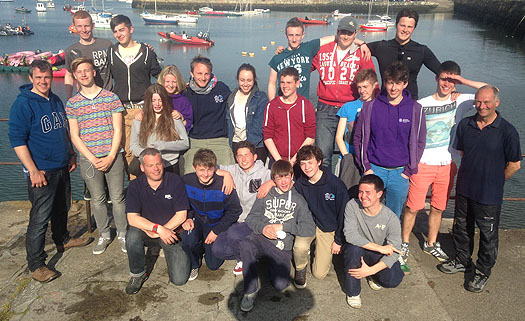
Running alongside this course was our second ISA instructor course of the year. Under pressure for the course to actually run and be a success, we are hugely grateful to Eddie English of SailCork.com for freeing up his busy schedule to come and run our course up in Dublin.
Finally if our instructor courses, coaching weekends and racing weren't keeping us busy enough, we have had some fantastic weekends of teaching courses for adults with almost 20 newly qualified sailors already this year... some of these sailors are already sailing in our club system allowing them to keep their new found hobby alive. But don't forget the Junior sailors who with the good weather we have had over the last week had a fantastic Easter sailing course in the warmest conditions so far this year, though some regretted the inevitable jump into the sea once they found out the sea temperatures haven't quite risen yet!
All in all we have had a fantastic start to the year and are looking forward to a fantastic summer ahead.


